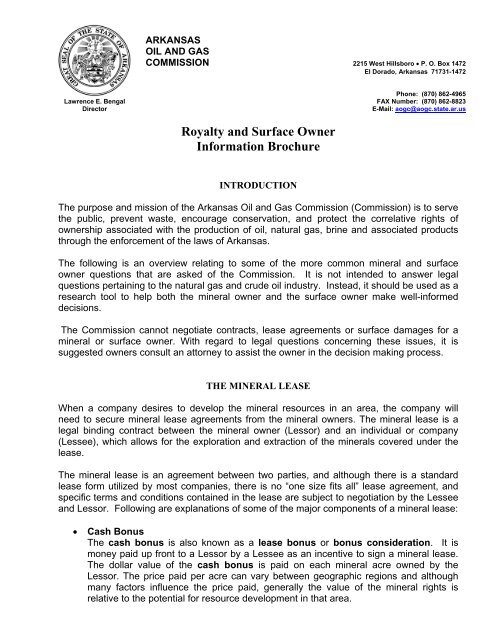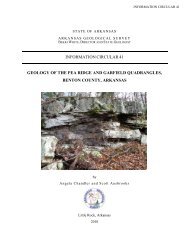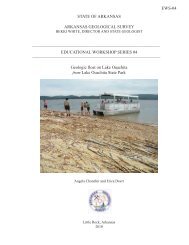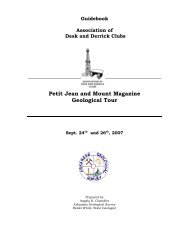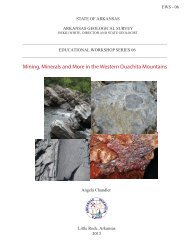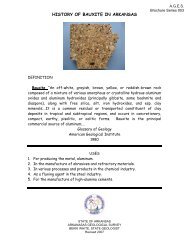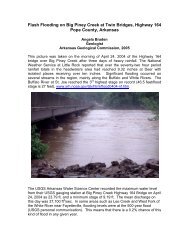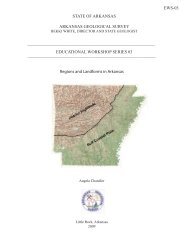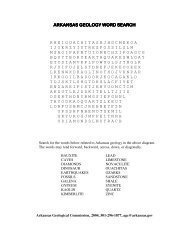Royalty and Surface Owner Information Brochure
Royalty and Surface Owner Information Brochure
Royalty and Surface Owner Information Brochure
- No tags were found...
Create successful ePaper yourself
Turn your PDF publications into a flip-book with our unique Google optimized e-Paper software.
ARKANSASOIL AND GASCOMMISSION 2215 West Hillsboro • P. O. Box 1472El Dorado, Arkansas 71731-1472Phone: (870) 862-4965Lawrence E. Bengal FAX Number: (870) 862-8823DirectorE-Mail: aogc@aogc.state.ar.us<strong>Royalty</strong> <strong>and</strong> <strong>Surface</strong> <strong>Owner</strong><strong>Information</strong> <strong>Brochure</strong>INTRODUCTIONThe purpose <strong>and</strong> mission of the Arkansas Oil <strong>and</strong> Gas Commission (Commission) is to servethe public, prevent waste, encourage conservation, <strong>and</strong> protect the correlative rights ofownership associated with the production of oil, natural gas, brine <strong>and</strong> associated productsthrough the enforcement of the laws of Arkansas.The following is an overview relating to some of the more common mineral <strong>and</strong> surfaceowner questions that are asked of the Commission. It is not intended to answer legalquestions pertaining to the natural gas <strong>and</strong> crude oil industry. Instead, it should be used as aresearch tool to help both the mineral owner <strong>and</strong> the surface owner make well-informeddecisions.The Commission cannot negotiate contracts, lease agreements or surface damages for amineral or surface owner. With regard to legal questions concerning these issues, it issuggested owners consult an attorney to assist the owner in the decision making process.THE MINERAL LEASEWhen a company desires to develop the mineral resources in an area, the company willneed to secure mineral lease agreements from the mineral owners. The mineral lease is alegal binding contract between the mineral owner (Lessor) <strong>and</strong> an individual or company(Lessee), which allows for the exploration <strong>and</strong> extraction of the minerals covered under thelease.The mineral lease is an agreement between two parties, <strong>and</strong> although there is a st<strong>and</strong>ardlease form utilized by most companies, there is no “one size fits all” lease agreement, <strong>and</strong>specific terms <strong>and</strong> conditions contained in the lease are subject to negotiation by the Lessee<strong>and</strong> Lessor. Following are explanations of some of the major components of a mineral lease:• Cash BonusThe cash bonus is also known as a lease bonus or bonus consideration. It ismoney paid up front to a Lessor by a Lessee as an incentive to sign a mineral lease.The dollar value of the cash bonus is paid on each mineral acre owned by theLessor. The price paid per acre can vary between geographic regions <strong>and</strong> althoughmany factors influence the price paid, generally the value of the mineral rights isrelative to the potential for resource development in that area.
It is important to realize that under the laws of conservation in the State of Arkansas themineral rights are dominant over the surface rights. Therefore, the surface owner iscompelled to allow a reasonable portion of their l<strong>and</strong> to be used for the development <strong>and</strong>production of the minerals unless the mineral owner added a “No <strong>Surface</strong> OperationClause” to the lease agreement.The Lessee holding the lease has a legal authority to enter the property for exploration <strong>and</strong>production even if the non-mineral owning surface owner objects to the intrusion on theproperty. That does not mean the surface owner will be without compensation. The amount<strong>and</strong> type of compensation is strictly a matter of negotiation between the surface owner <strong>and</strong>the company entering the property. If a mutual agreement cannot be reached, the surfaceowner always has the right to seek the advice of an attorney <strong>and</strong> relief through the courtsystem.The only surface owner’s protection under State law is the requirement to have the surface,where the drilling operations occurred, returned to reasonable condition after the drilling <strong>and</strong>production has ceased. Commission regulations ensure the proper plugging of the well;however, an attorney can be consulted for other surface damage claims.DIVISION ORDERAfter a well has been successfully drilled, the Lessee will forward the Lessor a documentcalled a Division Order. It usually contains information such as the legal description of theLessor’s name <strong>and</strong> address, legal description of the property, tax identification number <strong>and</strong>decimal interest based on the amount of mineral ownership.The information on the Division Order will need to be verified <strong>and</strong> a federal tax identificationnumber will have to be included. Otherwise, federal law requires 31% of your royalties to bepaid directly to the IRS by the Lessee holding the lease. For most individuals, the person’ssocial security number is the tax identification number. The Division Order needs to besigned <strong>and</strong> returned to the Lessee.TRANSFER ORDERIn the State of Arkansas when a person sells a piece of property the mineral rightsautomatically transfer with the surface rights, unless otherwise stated in the deed.When there is a change in mineral ownership resulting from an inheritance, survivorship,purchase of minerals, marital status or any other form of revision, it is the responsibility ofthe individual who is to receive royalty payments to notify the Lessee of the change.A certified letter to the Lessee stating what changes have occurred along with copies of thesupporting documents will expedite the process <strong>and</strong> eliminate unnecessary delays.
STATE INTEGRATION OF INTERESTSThe Commission, in accordance with State statute, has established drilling units consisting ofa set amount of acreage for the purpose of protecting correlative rights. Given oil <strong>and</strong> gasresources are mobile within a reservoir during the production process, the establishment ofdrilling units, of a specific acreage size, ensures all mineral owners potentially impacted bythe producing well will receive proper compensation for the oil <strong>and</strong> gas produced from a unit.A company desiring to explore for <strong>and</strong> develop oil <strong>and</strong> gas resources is required to payproduction royalties to the mineral owners in these established drilling units. When a mineralowner does not enter into a mineral lease with a company wanting to produce the oil <strong>and</strong> gasfrom a drilling unit, Arkansas statute provides for an integration of the unleased mineralinterest in order to allow the well to be drilled to recover the oil <strong>and</strong> gas resources. TheIntegration provisions contained in Arkansas State statute, as administered by theCommission, were adopted to ensure all mineral owners receive proper payment ofproduction royalties.It is the expectation of the Commission that entities desiring to drill <strong>and</strong> operate an oil or gaswell in Arkansas will attempt in good faith to negotiate a satisfactory mineral lease withmineral owners before resorting to the integration provisions of Arkansas statute. However,if the company or individual desiring to develop the oil <strong>and</strong> gas <strong>and</strong> the mineral owner cannotagree on acceptable lease terms, the company or individual (Applicant) can make applicationto the Commission for an Integration Order.The process begins with an application submitted to the Commission by the company orindividual seeking an Integration Order. All interested parties are given notice of when <strong>and</strong>where the Commission will hear the integration application. Commission Hearings are heldmonthly, generally the fourth Tuesday of each month, alternating between the Commission’sEl Dorado <strong>and</strong> Ft. Smith offices. The exact meeting dates can be found on theCommission’s web page at www.aogc.state.ar.us.At the hearing the Commission will take testimony from the Applicant <strong>and</strong> any otherinterested party concerning the application. After hearing the testimony presented, theCommission will decide whether or not to grant the integration application <strong>and</strong> what termsshould be granted to the unleased mineral royalty <strong>and</strong> leasehold working interest owners. Ifan Integration Order is granted, the unleased mineral royalty owners <strong>and</strong> leasehold workinginterest owners will be afforded various options for integration of the unleased interests. Forpurposes of this brochure, however, only the options pertaining to royalty mineral interestowners will be presented.The majority of Integration Orders will contain three active options <strong>and</strong> one passive option.Unleased mineral owners will have a 15-day election period from the date the order is signedto select one of the options. Although the options may contain variances on a case-by-casebasis, the following is a summary of the common options:LEASE - Sign a lease for the bonus <strong>and</strong> royalty specified by the Commission, which isusually the highest amount offered <strong>and</strong> accepted by other mineral owners in the unit beforethe integration application was submitted to the Commission. A lease signed during the 15-day election period has a term of one year, or as long thereafter as production is occurringfrom the unit.
PARTICIPATE - Participate in the unit by signing an operating agreement, which generallyfollows the Model Form Operating Agreement, A.A.P.L. 610-1989 with COPAS 1984Accounting Procedure. Under this option the mineral owner will receive the proportionateshare of the 1/8th royalty, <strong>and</strong> in addition will also pay the proportionate share of the wellcost, whether the well is successful or not. If the well is successful, the mineral owner willreceive the proportionate share of the well proceeds.ELECT NON-CONSENT - This option is similar to the PARTICIPATE option, with theexception that the costs of participation in the well are carried by the operator. Under thisoption, the unleased mineral owner will receive the proportionate share of the 1/8 th royalty,but will not receive the lease bonus. In addition, the unleased mineral owner will receive theproportionate share of the production revenue from which the operator will withhold thenecessary proceeds to pay the operator for the drilling cost plus any risk factor deemedappropriate by the Commission. The risk factor or penalty is variable based on the potentialrisk of drilling a successful well, but is commonly 400% - 600%. As an example, if anunleased mineral owner were to elect the non-consent option in a well with a 400% penaltyfactor, the operator would automatically withhold the unleased mineral owners productionrevenue (excluding the 1/8 th royalty) until four times the mineral owners percentage of thedrilling, completing <strong>and</strong> well equipping costs, plus 100% of operations expenses arerecovered by the operator. If <strong>and</strong> when, the drilling cost obligations have balanced, themineral owner would receive the proportionate share of the production revenue, lessoperation expenses, from that time forward in addition to the continued 1/8 th royaltypayments.NO RESPONSE - All of the above options require the unleased mineral owner to notify theoperator of the selected choice. The “NO RESPONSE” option requires no action on the partof the mineral owner. If the unleased mineral owner does not notify the operator <strong>and</strong> selectone of the above options within the election period specified in the Integration Order, theunleased mineral interest will be deemed integrated <strong>and</strong> the mineral owner will receive alease bonus <strong>and</strong> royalty amount specified by the Commission. Under the “NO RESPONSE”option, the mineral owner will lose the option to elect participation in future wells drilled withinthe unit.At this time, the law in Arkansas is unclear as to what rights an operator of an integrated unithas, relative to surface access necessary to drill a well, on the unleased mineral interests,under the “ELECT NON-CONSENT” or “NO RESPONSE” options above. The operator will,however, have the right to drain oil or gas from all the integrated interest acreage. It isimportant to note, however, that if another party owns a fractional interest in the mineralsunder a property, the owner of the partial minerals may have the right to give an oil <strong>and</strong> gascompany access to drill a well, whether or not the current surface owner <strong>and</strong> partial mineralowner execute a lease.FREQUENTLY ASKED QUESTIONSQ. I have inherited mineral rights. How do I transfer the royalty payments over to me?
A. Send a self-explanatory, certified letter to the well operator <strong>and</strong> include the followinginformation:• A copy of the death certificate or other relating documents.• A copy of the Last Will <strong>and</strong> Testament.• If the estate was probated through the courts, then send a copy of the Final Decree,Court Order or an Affidavit of Heirship.• A list of the legal names, addresses <strong>and</strong> tax identification numbers of the heirs whoare to receive royalties.• The operator may require additional information.Q. I have purchased a piece of property <strong>and</strong> the mineral rights were included. How doI transfer the royalty payments over to me?A. Send a self-explanatory letter to the operator <strong>and</strong> include the following information:• A copy of the deed showing that mineral ownership was transferred during the l<strong>and</strong>sale.• The legal name, address <strong>and</strong> tax identification number of the entity who is to receivethe royalties.Q. A company has approached me about drilling a well in my section. What optionsdo I have?A. If the property owner owns the minerals, an unleased mineral interest owner hasthree basic options, 1) voluntarily negotiate a mineral lease agreement with thecompany, 2) request to participate in the well, or 3), in the absence of an agreement,be subject to an integration proceeding before the Commission, at which time theoptions discussed under the “State Integration of Interests” section of this brochurewill be offered.Q. How do I know the cash bonus <strong>and</strong> conditions that are being offered are fair?A. The terms <strong>and</strong> conditions of the mineral lease agreement are negotiable <strong>and</strong> can varyfrom one geographical region to another. The price paid per acre can also vary betweengeographic regions, <strong>and</strong> although many factors influence the price paid, generally the valueof the mineral rights is relative to the potential for resource development in that area. It isalways a good practice to check with neighbors, friends, real estate agents <strong>and</strong> individualswithin the oil <strong>and</strong> gas industry to compare what cash bonuses are being offered.Q. I’ve been told that our minerals are being force integrated. What does that mean?A. Forced integration is a process that is used to ensure the orderly development of thecrude oil <strong>and</strong> natural gas resources in the State of Arkansas. There are times when amineral owner cannot be located or the mineral owner chooses not to participate or sign alease agreement. When this situation occurs, the operator may ask the Arkansas Oil & GasCommission, whose mission is to protect the correlative rights of all parties, to integrate allunleased mineral owners. The process of integration was discussed earlier in this brochure.Q. I don’t own the mineral rights to my property <strong>and</strong> a company wants to drill on myl<strong>and</strong>. Can I stop them? What are my options?
A. It is not uncommon for part or all of the mineral ownership to have been severed from thesurface ownership at the time of the l<strong>and</strong> sale. In the State of Arkansas, the mineral rightsare dominant over the surface rights, <strong>and</strong> state law requires the surface owner allow areasonable portion of their l<strong>and</strong> to be utilized for drilling <strong>and</strong> production. Unless the mineralowner, prior to the sale of the surface, negotiated a mineral lease agreement that specificallystates “No <strong>Surface</strong> Operations”, then the company holding the lease can enter the propertyfor exploration <strong>and</strong> production. Most operators will negotiate payment for surface damages;however, law does not require damage payments. If the Lessee’s activities are excessive ofthose activities reasonably required to explore for <strong>and</strong> produce oil <strong>and</strong> gas resources or theLessee is negligent or fails to restore the surface area, the surface owner can seek thecounsel of an attorney <strong>and</strong> relief through the court system.Q. A new gas well has been drilled in my section or there is a gas well in my sectionthat has been producing for some time. When can I expect my royalty check?A. At the end of a well’s initial month of production, a grace period of six (6) months <strong>and</strong>twenty days is allowed before the royalty payments are to be made to the mineral owners.As an example, if gas was first sold in January the company has until August 20 th to beginpaying royalties.There is an exception. The royalty payment may be postponed until the royalty revenuereaches a minimum of one hundred-dollars ($100) or, until the end of the calendar year,when royalties total less than one hundred dollars.Q. I’m not getting a royalty check. What should I do?A. There are many reasons an individual may not receive a royalty check. The first step is toconfirm that you own the minerals by researching your property deed. If you own theminerals, contact the operator <strong>and</strong> inquire as to why royalties are not being paid. Theoperator will research the issue <strong>and</strong> make the necessary corrections. The AOGC can providecontact information if necessary by contacting one of the Commission offices with the legaldescription (section, township <strong>and</strong> range) of your property.Q. How do I find out if I own the mineral rights to my property?A. In the State of Arkansas, the mineral rights are considered part of the sale with thesurface rights unless they have been specifically reserved. A review of the property abstractshould indicate if the mineral rights were reserved by a former property owner. A review ofthe warranty deed at the Circuit Clerk’s office will also indicate mineral ownership. Inaddition, an attorney, abstract company, or a l<strong>and</strong> man may be contacted for assistance.Q. The company that operates the well I’m receiving royalty from has sold the well toanother company. Will this affect my royalty checks?A. Oil <strong>and</strong> gas wells are property that can be bought <strong>and</strong> sold. It’s not uncommon for a wellto have changed h<strong>and</strong>s several times during the course of its life. You may notice a differentlooking revenue statement, payment schedule, or some other visual change. However, the
esponsibility for royalty payments is still intact <strong>and</strong> is passed on to the new operator. You willstill receive royalty payments; it will just be from the new company.Q. I have recently changed my marital status. How do I make that change to myroyalty account?A. Send a self-explanatory letter to the company that operates the well, <strong>and</strong> include thefollowing information:• A copy of a past revenue statement with your identification number listed,• A copy of your marriage license, <strong>and</strong>• Legal name, address <strong>and</strong> social security number of the entity that is to receive theroyalty.Q. I need to change my name due a court proceeding. How do I make that change tomy royalty account?A. Send a self-explanatory letter to the company that operates the well <strong>and</strong> include thefollowing information:• A copy of a past revenue statement with your identification number listed.• A copy of the court order.• The legal name, address <strong>and</strong> social security number of the entity who is to receive theroyalties.TO CONTACT THE COMMISSION:OIL AND GAS COMMISSIONOIL AND GAS COMMISSION2215 W. HILLSBORO 3309 W. PHOENIX AVENUEEL DORADO, ARKANSAS 71731 FT. SMITH, ARKANSAS 72903PHONE 870-862-4965 PHONE 479-646-6611FAX 870- 862-8823 FAX 479-649-7656E-Mail: aogc@aogc.state.ar.usE-Mail: aogc@aogc.state.ar.usFOR ADDITIONAL INFORMATION:THE ARKANSAS LEASING MANUALCharles A. MorganTexarkana, Arkansascamorgan@dnmlawfirm.comCONFLICTS BETWEEN SURFACE OWNERS AND MINERAL LESSEESRick D. Davis, Jr.Midl<strong>and</strong>, Texashttp://www.cottonbledsoe.com/CM/Articles/ConflictPaperAllStates.pdf


